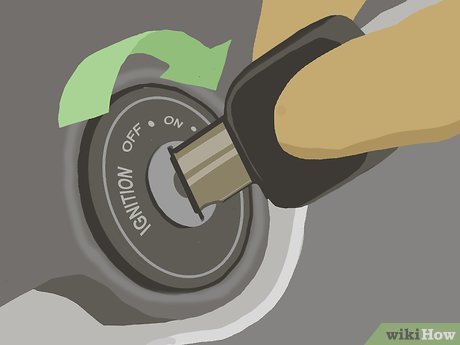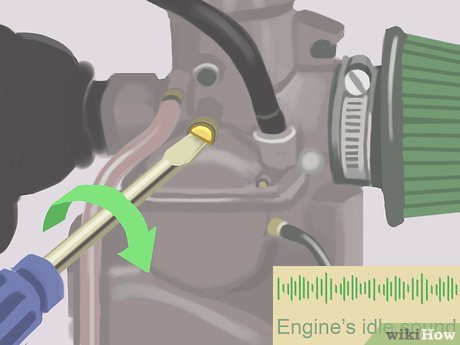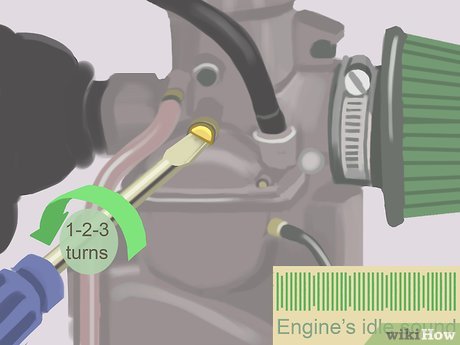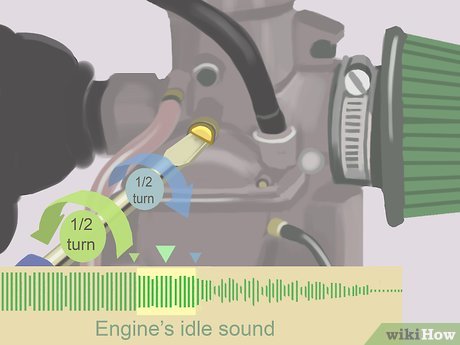An air fuel mixture screw is a special screw on an engine’s carburetor that controls how much air mixes with the fuel. Adjusting this screw changes how fast or slow an engine idles and how smoothly it runs. The basic process for adjusting an air fuel mixture screw is the same for all small engines, whether it’s on a car, motorcycle, or other type of engine. Make adjustments with the engine warmed up and running. Set the screw in the position where the engine idles most smoothly and doesn’t sound rough or irregular to balance the fuel mixture so that the engine has an ideal air fuel ratio.
StepsPart 1Part 1 of 2:Accessing the Air Fuel Mixture Screw
1Start the engine and let it run for 5 minutes to warm it up. Turn the key in the ignition to start the engine. Warm up the engine to normal operating temperature by letting it idle for about 5 minutes. Keep the engine running after it warms up.XAlways make air fuel mixture screw adjustments with a warm engine and the engine running, so you can listen to how the adjustments affect the engine’s idle speed.Note that this process is the same for any type of engine with an air fuel mixture screw. It could be a car, motorcycle, scooter, ATV, or anything else with a carburetor.
Tip: An air fuel mixture screw is also known as an idle mixture screw.X

2Locate the carburetor by finding the engine’s air filter. Look at the engine and spot the round or cone-shaped air filter. The carburetor is the part of the engine that the air filter is attached to.XThe air filter on a car might be large and round. It usually sits on top of the carburetor.On a motorcycle, the air filter usually comes off the side of the engine and faces the rear of the bike.
3Find the flat-headed, slotted, gold-colored brass screw on the carburetor. Look at all the different screws on the carburetor until you spot the gold one with a flat slotted head. This is the air fuel mixture screw.XMost air fuel mixture screws are located on the side of the carburetor, but it depends on the specific engine.Part 2Part 2 of 2:Balancing the Fuel Mixture
1Turn the screw clockwise until the engine starts to sound rough. Use a flathead screwdriver to tighten the screw. Listen to the engine’s idle sound and stop turning the screw when it starts making a rough rising and falling sound instead of its normal idling sound.XTightening the screw weakens the air and fuel mixture and decreases the amount of fuel flowing to the engine.Tightening the screw is also called making the fuel mixture leaner, which lowers the RPMs at which the engine idles.Running a lean fuel mixture makes the engine run with less fuel than it needs to run efficiently. This can damage an engine because there is more friction between moving parts and the engine operates at a higher temperature.
2Loosen the screw and count the turns until the engine sounds irregular. Use your flathead screwdriver to turn the screw counterclockwise, counting the number of rotations you make as you go. Listen to the idling of the engine and stop turning the screw when the engine’s idle sound starts sounding irregular, like it is revving too fast.XLoosening the screw strengthens the air and fuel mixture and increases the amount of fuel flowing to the engine.Loosening the screw is also called making the fuel mixture richer, which increases the RPMs at which the engine idles.Running a rich fuel mixture causes the engine to run with more fuel than it needs to operate efficiently. This means that it will burn fuel much faster than necessary, although the engine may run with more power and at a cooler temperature.
3Set the screw in the middle between the rough- and irregular-sounding spots. Turn the screw back clockwise until it is approximately in the middle location between where the engine’s idle sounds irregular and rough. This will set the engine at a regular idle speed.XFor example, if you turned the screw 2 full turns counterclockwise from the spot where the engine’s idle started to sound rough, now turn the screw clockwise 1 full turn.
4Make adjustments 1/2 a turn in either direction to find the smoothest idle speed. Turn the screw counterclockwise and clockwise 1/2 a turn from the middle position and listen to the sound of the idle. Set the screw in the position where the engine’s idle sounds most even and smooth to balance the fuel mixture.XYou might notice that turning the screw 1/2 a turn in either direction makes the engine start to sound rougher or more irregular, in which case you can just set the screw back to the middle position.This adjustment process is also known as balancing the idle mixture.Most engines have an ideal air fuel ratio, or AFR, around 14.7:1. You could find your engine’s exact AFR using a special meter, but this isn’t really necessary unless you want to be ultra-precise, such as if you’re tuning a high-performance race car or motorcycle.X
Tip: The factory position for most air fuel mixture screws is usually between 1.5 and 2.5 turns out from being screwed all the way in. If you ever want to start fresh, turn the screw clockwise until it is lightly seated, then back it out about 2 turns. Then you can make adjustments from this position.X








